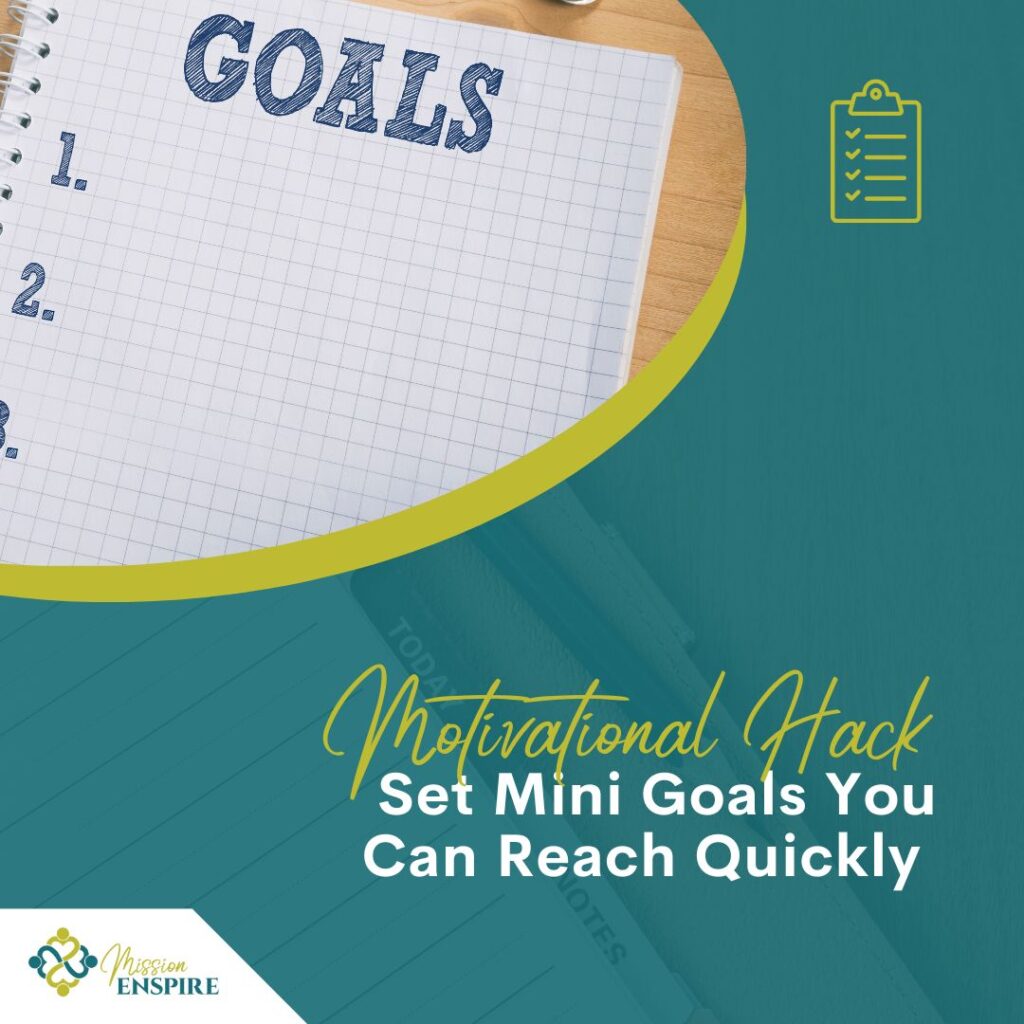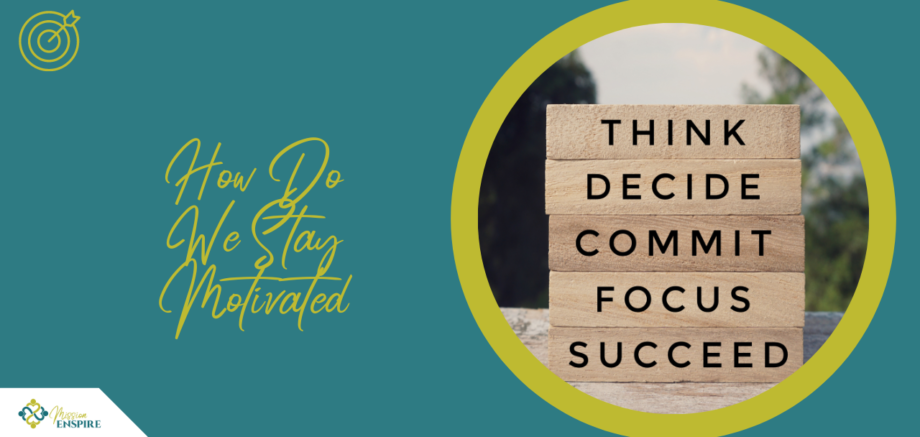Last week, we talked about goal setting and how it can be a powerful jumping-off point for making a change in your life, whether it’s personal, professional, financial, or some combination of those. But once you’ve set your goals—then what? How do we stay motivated to keep working toward that goal?
One of the reasons it can feel difficult to stick to our goals is because we don’t always see big results right away. It often doesn’t matter what our specific goal is—whether we’re trying to start and keep up with an exercise routine, launch a business, save money, or quit smoking. Many of us stick with the program for a few weeks and then start to lose steam and motivation. It takes a lot to keep going and it isn’t easy to change our habits for the better. What we need to stay on track is a little motivation. If we can see that we’re moving in the right direction (even if it isn’t always as fast as we’d like it to be), we’ll keep going and opt to take that brisk exercise walk, take that money we were tempted to spend on a treat and put it into our savings account instead, sketch out that first draft of our business plan, or resist that urge to have a cigarette.

But how do we see this progress? We see it by tracking and measuring and writing it down. It doesn’t matter if you use a pen and paper, your computer, an app on your phone, or some other tracking solution that works for you. You want to be able to see that progress in front of you in black and white! Let’s talk about what to track. If you want to work on your fitness, you can write down your planned workouts, or log your workouts in an app, a notebook, or spreadsheet as you complete them. Or you can use a spreadsheet or an app to track your spending and savings if you’re working toward a personal finance goal. And having all this data can be very motivating: six months into your journey, you may not see a lot of change day to day, but looking back at where you were on Day One and how far you’ve come already will keep you going.
If your goal is to stop smoking, make a check mark on your calendar for each day you make it without a cigarette. As the check marks start to add up, so will your resolve to keep it up. If your goal is to pay down credit card debt, or build a financial safety net, keep a running total of your numbers. It doesn’t matter what your goal is, keeping track of how you’re doing and how far you’ve come already can be a big motivator to stick to the plan until you reach your goal.

Big goals are good things to have. There’s nothing wrong with being ambitious. But what if you’ve made a goal so big that you’re having a hard time motivating yourself to get started and/or keep going? Perhaps everything was going well for a few weeks, but then your motivation started to slip. This is why coaches like me work with our clients to break that bigger vision and those ambitious goals down into smaller steps and along the way. Think of it as a motivational hack. It’s all about setting mini goals that you can reach quickly. Here’s what can happen when you reach each mini goal along the way.
It Makes You Feel Successful. It feels good when you reach a goal, doesn’t it? It’s internal positive reinforcement. You cheer yourself on and get all pumped up. Why not take advantage of that great feeling of success throughout your journey to reach your big goal. Set those mini goals and celebrate reaching each milestone. If you’re working on growing your savings or paying down credit card debt, you may want to set smaller mini goals: for example, saving $10 per week rather than focusing on saving $40 per month. Celebrate each time you reach that next mini goal and bask in your success. Use the motivation to tackle those next savings deposits.
It Shows You That You’re Making Progress. Reaching each mini goal also means you’re a step closer to your end goal. You’re making actual, measurable progress. It’s easy to lose sight of that when you’re dealing with a bigger task or a large number. Those mini goals are visual proof that you’re moving in the right direction.
It Gives You A Boost of Confidence. Seeing that success and progress gives you a big boost of confidence. And rightfully so. You’re putting in the work and you are seeing the results. You should be proud. Put that confidence to good use. You’ve got this.
Don’t be afraid to share your success with loved ones. Getting praise for reaching each mini goal can boost your confidence even further. (I’ll talk more in next week’s post about how we can enlist friends or family members as accountability partners to help us stick to our goals!) And don’t forget to give yourself a big pat on the back as well.

When you have a big goal it’s hard to stay excited and motivated about it for weeks and months to come. For example, we all know we should get more active and exercise at least a few times a week. But that doesn’t mean we look forward to it or that it’s easy to carve out the time in our busy schedules. What do you do to keep going and stay motivated to lace up those walking or running shoes each day? You can reward yourself along the way. Think about what would motivate you as a reward. Maybe it’s a fun new T-shirt to wear on your workouts, maybe it is pizza and a movie after a week of working out. Maybe it’s a small treat that makes you feel good but doesn’t eat too much into your savings or debt payoff plan, if you’re working on a financial goal. Start by figuring out what your reward will be. Feel free to mix and match. The goal here is to keep yourself motivated. Then figure out what you need to do to “deserve” your special reward. Make it a challenge but keep it attainable.
Work hard to reach your mini goal and then celebrate and enjoy your reward. Rinse and repeat until you reach your end goal. Keep a visual reminder of your reward around if you find it helpful. Cut out a picture of that beach where you want to vacation once you’ve hit your savings goal, or a photo that represents how you’ll feel when you’re debt-free. Or spend a few minutes browsing through Netflix each evening after your workout contemplating what movies or shows you’ll watch while you veg on the couch this weekend. I do a vision board at the beginning of every year and keep it posted someplace where I’ll see it regularly. I also make sure to set myself a quarterly “appointment” to review my goals, progress, and update my vision board.
Pick your rewards and put them to work. See if having that little carrot dangle in front of you won’t get you to stick to your resolution. If one particular reward just doesn’t seem to keep you motivated, feel free to switch it up and try something else. Just be careful you don’t sabotage your progress with your reward. Use common sense and just try it. See what ends up motivating you the most and keep using those reward. These can all be great tips for staying motivated but what if you need a little more help to stick with your goals? (Spoiler alert, most of us do—including me!) This is where a friend, a family member, or a trusted coach who can serve as an accountability partner comes in. In next week’s post, we’ll tackle the topic of accountability: how to hold yourself accountable on your path to reaching your goals, and who else in your life you can enlist to help you along the way.

